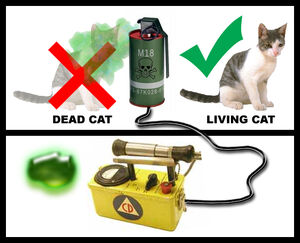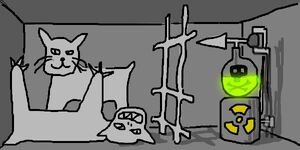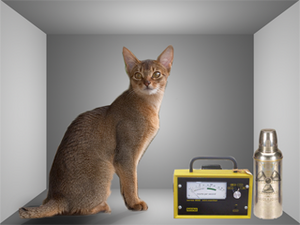Assessment |
Biopsychology |
Comparative |
Cognitive |
Developmental |
Language |
Individual differences |
Personality |
Philosophy |
Social |
Methods |
Statistics |
Clinical |
Educational |
Industrial |
Professional items |
World psychology |
Cognitive Psychology: Attention · Decision making · Learning · Judgement · Memory · Motivation · Perception · Reasoning · Thinking - Cognitive processes Cognition - Outline Index

Schrödinger's Cat: If the nucleus in the bottom left decays, the geiger counter on its right will sense it and trigger the release of the gas. In one hour, there is a 50% chance that the nucleus will decay, and therefore that the gas will be released and kill the cat.
Schrödinger's cat is a seemingly paradoxical thought experiment devised by Erwin Schrödinger that attempts to illustrate the incompleteness of an early interpretation of quantum mechanics when going from subatomic to macroscopic systems. Schrödinger proposed his "cat" after debates with Albert Einstein over the Copenhagen interpretation, which Schrödinger defended, stating in essence that if a scenario existed where a cat could be so isolated from external interference (decoherence), the state of the cat can only be known as a superposition (combination) of possible rest states (eigenstates), because finding out (measuring the state) cannot be done without the observer interfering with the experiment — the measurement system (the observer) is entangled with the experiment.
The thought experiment serves to illustrate the strangeness of quantum mechanics and the mathematics necessary to describe quantum states. The idea of a particle existing in a superposition of possible states, while a fact of quantum mechanics, is a concept that does not scale to large systems (like cats), which are not indeterminably probabilistic in nature. Philosophically, these positions which emphasise either probability or determined outcomes are called (respectively) positivism and determinism.
The experiment[]
Schrödinger wrote:
One can even set up quite ridiculous cases. A cat is penned up in a steel chamber, along with the following device (which must be secured against direct interference by the cat): in a Geiger counter there is a tiny bit of radioactive substance, so small, that perhaps in the course of the hour one of the atoms decays, but also, with equal probability, perhaps none; if it happens, the counter tube discharges and through a relay releases a hammer which shatters a small flask of hydrocyanic acid. If one has left this entire system to itself for an hour, one would say that the cat still lives if meanwhile no atom has decayed. The psi-function of the entire system would express this by having in it the living and dead cat (pardon the expression) mixed or smeared out in equal parts.
It is typical of these cases that an indeterminacy originally restricted to the atomic domain becomes transformed into macroscopic indeterminacy, which can then be resolved by direct observation. That prevents us from so naively accepting as valid a "blurred model" for representing reality. In itself it would not embody anything unclear or contradictory. There is a difference between a shaky or out-of-focus photograph and a snapshot of clouds and fog banks.— [1]

An illustration of both states, a dead and living cat. According to quantum theory, after an hour the cat is in a quantum superposition of coexisting alive and dead states. Yet when we look in the box we expect to only see one of the states, not a mixture of them.

The experiment must be shielded from the environment to prevent quantum decoherence from inducing wavefunction collapse.
The above text is a translation of two paragraphs from within a much larger original article, which appeared in the German magazine Naturwissenschaften ("Natural Sciences") in 1935: E. Schrödinger: "Die gegenwärtige Situation in der Quantenmechanik" ("The present situation in quantum mechanics"), Naturwissenschaften, 48, 807, 49, 823, 50, 844 (November 1935). It was intended as a discussion of the EPR article published by Einstein, Podolsky and Rosen in the same year. Apart from introducing the cat, Schrödinger also coined the term "entanglement" (German: Verschränkung) in his article.
In posing this Schrödinger asked the question: when does a quantum system stop existing as a mixture of states and become one or the other? (More technically, when does the actual quantum state stop being a linear combination of states, each of which resemble different classical states, and instead begin to have a unique classical description?) If the cat survives, it remembers only being alive. But explanations of the EPR experiments that are consistent with standard microscopic quantum mechanics require that macroscopic objects, such as cats and notebooks, do not always have unique classical descriptions. The purpose of the thought experiment is to illustrate this apparent paradox: our intuition says that no observer can be in a mixture of states, yet it seems cats can be such a mixture. Are cats required to be observers, or does their existence in a single well-defined classical state require another external observer? Each alternative seemed absurd to Albert Einstein, who was impressed by the ability of the thought experiment to highlight these issues; in a letter to Schrödinger dated 1950 he wrote:
You are the only contemporary physicist, besides Laue, who sees that one cannot get around the assumption of reality—if only one is honest. Most of them simply do not see what sort of risky game they are playing with reality—reality as something independent of what is experimentally established. Their interpretation is, however, refuted most elegantly by your system of radioactive atom + amplifier + charge of gun powder + cat in a box, in which the psi-function of the system contains both the cat alive and blown to bits. Nobody really doubts that the presence or absence of the cat is something independent of the act of observation.
But perhaps it was inevitable that Einstein would be impressed with Schrödinger's cat—Einstein had previously suggested to Schrödinger a similar paradox involving an unstable keg of gunpowder, instead of a cat. Schrödinger had taken the next step of applying quantum mechanics to an entity that may or may not be conscious, to further illustrate the putative incompleteness of quantum mechanics.
Copenhagen interpretation[]
| Quantum physics |
| Quantum psychology |
| Quantum mechanics |
|
Introduction to... |
| Fundamental concepts |
|
Decoherence · Interference |
| Experiments |
|
Double-slit experiment |
| Equations |
|
Schrödinger equation |
| Advanced theories |
|
Quantum field theory |
| Interpretations |
|
Copenhagen ·
Quantum logic |
| Scientists |
|
Bohm · |
In the Copenhagen interpretation, a system stops being a superposition of states and becomes either one or the other when an observation takes place. This experiment makes apparent the fact that the nature of measurement, or observation, is not well defined in this interpretation. Some interpret the experiment to mean that while the box is closed, the system simultaneously exists in a superposition of the states "decayed nucleus/dead cat" and "undecayed nucleus/living cat", and that only when the box is opened and an observation performed does the wave function collapse into one of the two states. More intuitively, some feel that the "observation" is taken when a particle from the nucleus hits the detector. Recent developments in quantum physics show that measurements of quantum phenomena taken by non-conscious "observers" (such as a wiretap) most definitely alter the quantum state of the phenomena from the point of view of conscious observers reading the wiretap, lending support to this idea.
A precise rule is that probability enters at the point where the classical approximation is first used to describe the system - almost by tautology, as the classical approximation is just a simplification of the quantum mathematics, and so must introduce imprecision in the measurement, which can be viewed as probability. Note, however, that this only applies to descriptions of the system, not the system itself. The cat is both 100% alive and 100% dead at the same time due to quantum theory.
Under Copenhagen, the amount of uncertainty for a complex quantum system is predicted by quantum decoherence. Particles which exchange photons (and possibly other atomic or subatomic particles) become entangled with each other from the point of view of an observer, meaning that these particles can only be described accurately with reference to each other, which decreases the total uncertainty of those particles from the point of view of our observer. By the time one has reached "macroscopic" levels - such as a cat, which is made up of a number of atomic particles almost too large to express with words - so many particles have become entangled with each other so as to decrease the uncertainty to almost zero. (Quantum effects in huge collections of particles are only seen in very rare, and often man-made, situations, such as a Bose-Einstein condensate). Thus, at least from the point of view of the observer, any improbability regarding the cat as a system of quantum particles has disappeared due to the massive amount of entanglement between all of the particles that make it up, meaning that the cat does not truly exist as both alive and dead at the same time, at least from the point of view of any observer viewing the cat.
Even before observation was noted to be fundamentally distinct from consciousness through experimentation, the experiment always contained at least two "observers" - the physicist and the cat. Even had the physicist been unaware of the cat's state in the hypothetical experiment, one would have had to posit that the cat, at least, would have been quite sure of its status (at least, as long as the gas had not yet ended its ability to "observe"). However, since "observation" has been shown by experiment to have nothing to do with consciousness - or at the very least, any traditional definition of consciousness - most conjecture along these lines probably falls under the "interesting but physically irrelevant" category.
Steven Weinberg in "Einstein's Mistakes", Physics Today, November 2005, page 31, said:
All this familiar story is true, but it leaves out an irony. Bohr's version of quantum mechanics was deeply flawed, but not for the reason Einstein thought. The Copenhagen interpretation describes what happens when an observer makes a measurement, but the observer and the act of measurement are themselves treated classically. This is surely wrong: Physicists and their apparatus must be governed by the same quantum mechanical rules that govern everything else in the universe. But these rules are expressed in terms of a wavefunction (or, more precisely, a state vector) that evolves in a perfectly deterministic way. So where do the probabilistic rules of the Copenhagen interpretation come from?
Considerable progress has been made in recent years toward the resolution of the problem, which I cannot go into here. It is enough to say that neither Bohr nor Einstein had focused on the real problem with quantum mechanics. The Copenhagen rules clearly work, so they have to be accepted. But this leaves the task of explaining them by applying the deterministic equation for the evolution of the wavefunction, the Schrödinger equation, to observers and their apparatus.
Everett many-worlds interpretation & consistent histories[]
In the many-worlds interpretation of quantum mechanics, which does not single out observation as a special process, both states persist, but decoherent from each other. When an observer opens the box, he becomes entangled with the cat, so observer-states corresponding to the cat being alive and dead are formed, and each can have no interaction with the other. The same mechanism of quantum decoherence is also important for the interpretation in terms of Consistent Histories. Only the "dead cat" or "alive cat" can be a part of a consistent history in this interpretation.
In other words, when the box is opened, the universe (or at least the part of the universe containing the observer and cat) is split into two separate universes, one containing an observer looking at a box with a dead cat, one containing an observer looking at a box with a live cat.
Ensemble interpretation[]
In the Ensemble Interpretation, the Schrödinger's cat paradox is a trivial non issue. In this interpretation, the state vector does not apply to individual cat experiments, it only applies to the statistics of many similar prepared cat experiments.
Indeed, the cat paradox was specifically constructed by Schrödinger to illustrate that the Copenhagen Interpretation suffered fundamental problems. It was not intended as an example that quantum mechanics actually predicted that a cat could be alive and dead simultaneously, though some have made this further assumption.
Practical applications[]
The experiment is a purely theoretical one, and the machine proposed is not known to have been constructed.
This has some practical use in quantum computing and quantum cryptography. It is possible to send light that is in a superposition of states down a fiber optic cable. Placing a wiretap in the middle of the cable which intercepts and retransmits the transmission will collapse the wavefunction (in the Copenhagen interpretation, "perform an observation") and cause the light to fall into one state or another. By performing statistical tests on the light received at the other end of the cable, one can tell whether it remains in the superposition of states or has already been observed and retransmitted. In principle, this allows the development of communication systems that cannot be tapped without the tap being noticed at the other end. This experiment can be argued to illustrate that "observation" in the Copenhagen interpretation has nothing to do with consciousness, in that a perfectly unconscious wiretap will cause the statistics at the end of the wire to be different. Yet, one still cannot factor out the observation of the wiretap as having an effect upon the outcome.
In quantum computing, the phrase "cat state" often refers to the special entanglement of qubits where the qubits are in an equal superposition of all being 0 and all being 1, i.e. + .
A variant of the Schrödinger's Cat experiment known as the quantum suicide machine has been proposed by cosmologist Max Tegmark. It examines the Schrödinger's Cat experiment from the point of view of the cat, and argues that this may be able to distinguish between the Copenhagen interpretation and many worlds. Another variant on the experiment is Wigner's friend.
Physicist Stephen Hawking once exclaimed, "When I hear of Schrödinger's cat, I reach for my gun," paraphrasing German playwright and Nazi "Poet Laureate", Hanns Johst's famous phrase "Wenn ich 'Kultur' höre, entsichere ich meine Browning!" ("When I hear the word 'culture', I release the safety on my Browning!")
In fact, Hawking and many other physicists are of the opinion that the "Copenhagen School" interpretation of quantum mechanics unduly stresses the role of the observer. Still, a final consensus on this point among physicists seems to be out of reach.
See also[]
- Quantum psychology
- Wigner's friend
- Quantum suicide
- Schroedinbug
- Double-slit experiment
- Basis function
External links[]
- Erwin Schrödinger, The Present Situation in Quantum Mechanics (Translation)
- A Lazy Layman's Guide to Quantum Physics
- Quantum Mechanics and Schrodinger's Cat
- The many worlds of quantum mechanics
- The Straight Dope's Poem of Schroedinger's Cat
- The EPR paper
Simple:Schrödinger's cat
| This page uses Creative Commons Licensed content from Wikipedia (view authors). |


